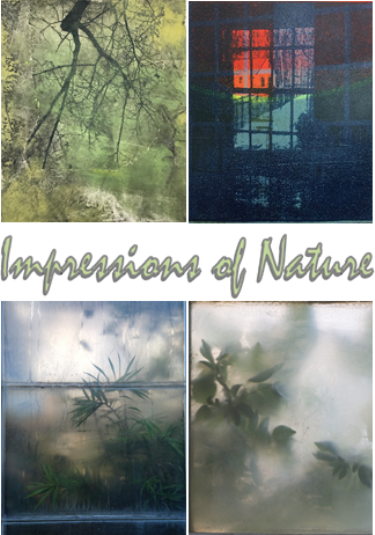On Exhibit in the Gallery…
Published January 14th, 2019

Impressions of Nature
Works by Lonnie Harvey & Amy Rindskopf
January 10th – March 13th, 2019
Artists’ Reception: Saturday, January 13th – 5-6 pm
Artist’s Statement ~
My monoprints are scenes painted from nature; landscapes, still lifes, and organic forms that are simple yet contain complexities of color and texture much like those often overlooked in the natural world. I am influenced by the places I have visited, inspired not only by the raw natural beauty but also the emotional responses they can elicit. Many of my images come from my own backyard, from the trees that surround my house, and from my walks through the woods. I attempt to translate these images through transition of colors, light, shapes, and texture.
Monoprints are described as painterly prints. They are one-of-a-kind prints, a unique process that combines painting and printmaking. The basic technique uses a “plate” (usually plexiglass) as a canvas. The painting is created with a variety of inks using rollers and paintbrushes. I use oil-based etching inks to achieve a richness and transparency of color. After my painting is completed, it is rolled through an etching press onto heavyweight printmaking paper. I use a variety of techniques in my work: chine-collé, collage, stencils, hand printing, multiple plates, viscosity printmaking, polyester plate lithography using photographic images, and different materials and found objects (such as cheese cloth or plant matter) to provide texture. Although a series of monoprints may contain similar images, no two are alike.
I try to approach each work as if putting together a jigsaw puzzle; different components are fitted together to produce a final result that is exciting and not always predictable!
The growing season in New England can be very short. As a nature photographer, I often visit greenhouses to stay with the green a little bit longer. I thought I would find comfort in the orderly life of the plants living and thriving, kept in orderly rows and beautiful tableaus by the gardeners.
But I found my interest drifting away from the center, towards the edges. This plant that grew between the walls of the greenhouse, that plant that leaned towards the light, away from the heat of the room, the press of its neighbors. I became fascinated with where the weathered frames of the greenhouse connected with the smooth leaves of the plants. Some days, I did not even go inside – what drew me were the light and color of the sun shining through the greenhouse, a vision of what might be. My end of season visits unveiled a dreaming world within the greenhouse. The plants stretch in unexpected ways, making their own way to the sun. Without words or voices, they make their desires known. I don’t need to know their names to see them yearning for the light, reaching for space, for a breath of fresh air.
The plants of my dreamed botany embody the aesthetic of wabi-sabi. A Japanese philosophy of art, wabi-sabi encompasses the idea that beauty is not perfect or permanent. Change and simplicity are central to this idea. The perfect blooming flower is not as beautiful as the decaying vine. The other-worldliness of the plants is grounded by the etched glass pane, the peeling wood frame, the rusting metal edge.
This exhibit would not be possible without assistance from the Friends of the Bedford Free Public Library.
The public is invited to view the exhibit during regular library hours.
